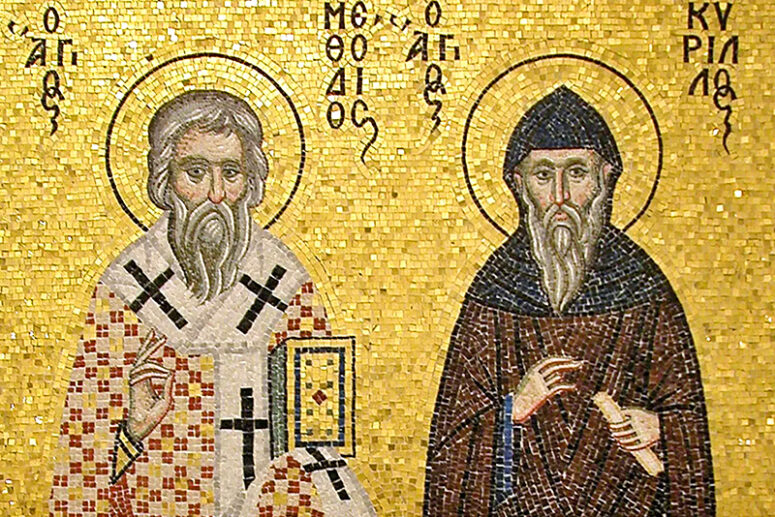
On May 24 the Orthodox Church celebrates the memory of Sts. Cyril and Methodius, the Equal-to-the-Apostles and teachers of the Slavs, who are considered the creators of the Slavonic alphabet and literary language. Much from the history of their lives and mission remains unknown to this day. For more on these holy brothers, we present the following interview with Anatoly Arkadyevich Turilov, Senior Researcher at the Department of Medieval History at the Institute of Slavic Studies of the Russian Academy of Sciences.

— Anatoly Arkadyevich, what exactly did Sts. Cyril and Methodius do in educating the Slavic peoples?
First of all, they created the literary Slavonic language on the basis of Bulgarian dialects, as well as the Slavonic written language, although this wasn’t the same alphabet we use now – it wasn’t the modern Cyrillic alphabet. They also translated Holy Scripture into Slavonic and laid the basis for both Slavonic divine services and Slavonic literature.
— What kind of people were they? What do we know about their characters and personalities?
The brothers came from the family of a mid-ranking Byzantine military official living in Thessalonica. It was a fairly well-to-do, educated family. Methodius was the eldest, a good bit older than Cyril. According to the life, Cyril was the youngest, the family’s seventh child.
In character, to the extent that we can deduce from their lives and other materials, they were fairly different people.
Cyril was, as they say, a God-given philologist. He learned languages well and loved doing so. Moreover, Cyril probably knew quite a few languages. Apart from Slavonic, he knew Hebrew. During one of his journeys, when he accompanied a mission to the caliphate as an interpreter, he became acquainted with Arabic. It’s obvious that, to some extent, he knew Latin as well as Syriac. St. Cyril’s knowledge of Syriac is the key to his subsequent creation of the Slavonic alphabet. It’s worth noting that not many people then knew Syriac, which again testifies to how highly educated he was. Building thereon, St. Cyril was subsequently able to model a literary language based on the spoken Slavic languages – because, as you know, literary language differs from spoken language. It had to be normalized and oriented on some model and, since Cyril was Greek, the orientation came from Greek.

Methodius followed the typical career of a Byzantine official from the beginning. In those days military and administrative service were not, in principle, separate things. He was appointed to oversee a certain district inhabited by Slavs. He clearly proved himself to be a good administrator. After the loss of his family, however, he was tonsured to monasticism and settled in Asia Minor, on the southern shore of the Sea of Marmara. It was from there that he later began to accompany his brother. Thus, the combination of a learned philologist with an administrator was a very successful one, leading to good results.
It’s also worth stating that the brothers were successful educators and teachers: they were able to leave an entire generation of disciples behind them. In this case, the activity of their disciples was as important as that of the brothers themselves. The holy brothers’ disciples, who came to Bulgaria in 885, created a large range of translations and new literary texts. It can be said that, without this generation of disciples, their mission wouldn’t have had the results that were eventually attained.
— How reliable is the information about the saints that has come down to us? What is historically accurate and what is legendary?
The historical evidence in this case is fairly limited.
Apart from their lives, there are very few other sources, nearly all of which are Latin.
On the one hand, little information from Byzantium has come down to us. Judging from the surviving historical evidence, no one was particularly interested in the mission. For example, Cyril was a disciple of Patriarch Photius, but there is no mention of either Cyril himself or of his mission in either the epistles or sermons of Photius. Therefore, the information here is limited.
On the other hand, from the moment that the hagiographies began to be studied, practically all researchers noted their high degree of reliability. Of course, some doubts can arise here. So, for example, Cyril’s life dedicates a great deal of space to his polemics with the heterodox and heretics. Whether this took place as described can be called into question. It’s more likely that the life made use of separate polemical treatises by Cyril, but that he didn’t actually speak like this as an orator.

As for legends, as a rule they arise later. So, for example, while the later hagiographical tradition calls Cyril an archbishop, this isn’t borne out by anything. It’s known that he didn’t hold the episcopal rank.
Another example: during the “nationalization” of Sts. Cyril and Methodius in Bulgaria in the twelfth century, it began to be claimed that they were Bulgarian through their mother. This is also a legend, not borne out by anything. In principle, the mechanism behind these versions is clear: “only one of our own could’ve created a written language for our people.”
On the whole, the ancient hagiographical tradition – that is, the lengthy lives of Sts. Cyril and Methodius – are texts of very great historical authenticity.
— What role did the brothers play in creating an alphabet for the Slavs?
In fact, it was only after the middle of the nineteenth-century that the view became established that, despite the modern alphabet being called “Cyrillic,” it wasn’t invented by Cyril. As you know, there are two Slavonic alphabets: Cyrillic and Glagolitic.
What is the evidence that Cyril created Glagolitic? Glagolitic is an artificial alphabet, patterned on Eastern alphabets. Given that Cyril knew Eastern languages, this isn’t surprising: if he knew the languages, he also knew the alphabets. It’s this artificiality that suggests that a single person invented it.
There is other evidence as well. For example, the numeral system in Glagolitic is completely independent, inasmuch as letters in Glagolitic also serve as numerals. In Cyrillic, however, the numeral system follows the Greek: letters missing from the Greek alphabet (for example, the Cyrillic letter “Be”) don’t have a numeric value. The presence of this numeral system is further evidence of the primacy of Glagolitic, because if Cyrillic had existed earlier, Glagolitic would’ve followed it in this regard.
Cyrillic is the result of the prolonged use of the Greek alphabet in Bulgaria from before that country’s acceptance of Christianity. Its formalization as a Slavonic alphabet took place at the turn of the ninth-tenth centuries AD. It amounted to the simultaneous joining of the Greek alphabet with the philological and linguistic principles that form the basis of Glagolitic.
Cyril’s genius as a philologist consisted in the fact that he created a very successful alphabetic system that takes into account the many particularities of any Slavic language and even some of its neighbors. The particularity of his Glagolitic, and then of the Cyrillic that adapted its principles, consists in the fact that no supplementary signs are needed in representing the letters – as, for example, in reproducing Slavonic letters into Latin. The letters are sufficient to reproduce the particularities of all sounds.

Cyril was able to take into account all the particularities of the different Slavic dialects. This has been subsequently confirmed by the fact that wherever various regional variants of the Cyrillic alphabet have been used, their creators have been able to make use of St. Cyril’s alphabet without changing hardly anything. Cyril succeeded in penetrating the formation and phonology of Slavonic so thoroughly that a universal alphabet with enormous reserves of potential was created. Moreover, these particularities were incorporated not only into Glagolitic, but also into Cyrillic.
— Was there an alphabet before them? Could Slavic culture have arisen without the involvement of Christianity?
Before Glagolitic, the Slavs had only various oral dialects, but there was no single literary language. These dialects were similar in many ways, which allowed the Greek and Latin contemporaries of the holy brothers to speak of the Slavs as a single people with a relatively uniform language.
Legend has it that when Cyril was on a diplomatic mission to Khazaria, he found a certain book written in “Russian letters” in Chersoneses (the site of today’s Sevastopol). For more than 150 years now, there’s been a debate about what these “Russian letters” were. Most likely, it was a matter of transposed letters: russkii [Russian] instead of sur’skii, that is, Syriac. As follows from the subsequent description, the language in question is Syriac. Already in the twelfth century, on the basis of this reading [of “Russian” rather than “Syriac”], the “Tale of Russian Letters” was born, which asserted that Russian letters were not invented, but rather sent by God to a certain Rusyn, who showed them to Cyril. This, of course, is a legend. We don’t have any real evidence of independent writing among the Slavs before the creation of Glagolitic.
As for the question of the emergence of Slavic culture without the persons of Sts. Cyril and Methodius, this would’ve been possible in principle. However, this wouldn’t have been possible without the Slavs’ acceptance of Christianity. The fact is that all alphabets created after the Birth of Christ necessarily arose on the basis of preceding ones, and this was connected with the Christianization of peoples. Thus, for example, the creation of the Gothic language and alphabet in the fourth century was connected with the Christianization of the Goths. The creation of the Ethiopian language was connected with the baptism of the Ethiopians, and so forth. Therefore the Christianization of peoples, the creation of indigenous literary languages, and the creation of alphabets are all part of a single inseparable process. This concerns the Slavic peoples above all, because with them we can visually compare the seeds sown by their holy first teachers with the mighty tree of Orthodox culture that has grown from them.

There is the Slavs’ acquisition of their own literary language, which in Rus’ survived as a single entity in all spheres of life until the beginning of the eighteenth century. There is also the acquisition of Slavonic liturgical and independent literatures. And, it goes without saying, the main thing was the translation of the Gospel into Slavonic, since the coming of Christianity to the Slavs in their own language was of such global significance that we’re probably incapable of fully recognizing its scale, inasmuch as we’re looking back at it from within after more than one thousand years. This was better understood and sensed by the authors of the lives of the holy brothers and their disciples, who characterized this event in the words of the Bible: “Following the word of the prophet, the ears of the deaf were opened, that they might hear the words of Scripture, and the tongue of stammerers spoke plainly” (Life of Cyril the Philosopher, chapter 15 [cf. Isaiah 35:5-6, LXX]). Here it should be noted that Sts. Cyril and Methodius saw their mission as apostolic and themselves as, in some sense, heirs of the Apostle Paul, since they were carrying the light of Christ’s teaching not to any single people, but to the Slavs in general.
— How did the Greek East (Constantinople) and the Latin West (Rome) react to the brothers’ activity?
It’s difficult to say how Constantinople reacted, since – as I’ve already mentioned – practically no information about this has survived. In the lives it’s stated that they were sent to Moravia (the border of today’s Czech Republic and Slovakia) by request of the local prince, but other Byzantine sources are silent about them. We shouldn’t, however, regard such silence as anything special, since the Byzantine sources generally say very little about any kind of mission, wherever they may have been sent, so in this sense the mission of Cyril and Methodius is no exception, but rather a confirmation of the rule. There is a certain reticence about the history of the mission itself, since the Moravian prince had asked for a “teacher and bishop,” but was sent only a teacher, not a bishop.
As for Rome, there are many difficulties here. It’s necessary to distinguish two things: the position of Rome itself and the position of the German bishops, since the holy brothers’ mission unfolded on lands on which German missionaries from the neighboring East Frankish kingdom, who had used Latin liturgically, had operated. Therefore, the question of competition was keener with regards to the neighboring German dioceses, while Rome continually maintained a floating policy. At times it supported the mission of Cyril and Methodius, while at other times it forbad the performance of services in Slavonic, ultimately banning it in 885. As has often happened in history, the mission became a card in a complicated political game. At an early stage, it was advantageous to Rome to support it and even to create a separate archdiocese (formally reviving an old one, centered in the city of Sirmium, north of today’s Belgrade). By agreement between the Papal See and the Moravian princes, Methodius was assigned to this cathedra in 869 (Cyril had died six months earlier in Rome).
In some sense, this option suited everyone. The Moravian princes got their bishop. The situation was also good enough for Constantinople, because no one there doubted Methodius’ commitment to the values of Byzantine Orthodoxy and the Emperor. The Papal See, on the one hand, restricted the influence of the German bishops, who carried out policies that didn’t always agree with Rome. On the other hand, perhaps even more importantly, the establishment of the cathedra of Sirmium with services in Slavonic opened up the possibility of spreading Papal influence among the many Balkan Slavs and, potentially, for returning to the authority of the Pope the entire diocese of Illyricum (the Balkan Peninsula excluding Constantinople and its environs), which had been transferred to Constantinople’s jurisdiction back in the first half of the eighth century. However, with regard to the Slavonic services, Rome’s position – as has already been stated – changed frequently (it was dictated by the political situation of the given moment): from permission for the partial use of Slavonic in divine services as a second language (after Latin) to a total ban. After the death of Methodius in 885, there came a final ban, accompanied by the expulsion and sale into slavery of the archbishop’s disciples. But the apparent defeat in the lives of the holy brothers in Moravia was almost immediately replaced by the triumph of their disciples’ joyful acceptance in Bulgaria.





